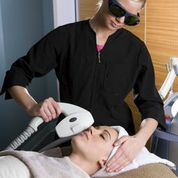 Some of the most innovative and advanced technologies in facial rejuvenation fall within the category of energy-based treatments. Energy-based refers to treatments that use medical devices to apply various types of energy to the face to achieve rejuvenating effects. While there are several types of energy used (laser, light, radiofrequency and ultrasound), they all work on the same structures of the skin, in similar ways. To get a better idea of how these energy-based technologies work, there needs to be a basic understanding of the structures of the skin. The top or outermost layer of the skin, the part exposed to the world, is the epidermis. The layer beneath the epidermis is called the dermis. This is where the underlying structures of the skin that support the epidermis are located. Beneath the dermis lie connective tissues, muscles and fat, and beneath that is bone.
Some of the most innovative and advanced technologies in facial rejuvenation fall within the category of energy-based treatments. Energy-based refers to treatments that use medical devices to apply various types of energy to the face to achieve rejuvenating effects. While there are several types of energy used (laser, light, radiofrequency and ultrasound), they all work on the same structures of the skin, in similar ways. To get a better idea of how these energy-based technologies work, there needs to be a basic understanding of the structures of the skin. The top or outermost layer of the skin, the part exposed to the world, is the epidermis. The layer beneath the epidermis is called the dermis. This is where the underlying structures of the skin that support the epidermis are located. Beneath the dermis lie connective tissues, muscles and fat, and beneath that is bone.
Energy-based facial rejuvenation treatments work by treating two areas: the top layer of skin, or epidermis, as well as the collagen and elastin structures that hold up the skin in the underlying dermis.
With laser devices, the skin of the patient is subjected to laser energy, usually “fractionally”, meaning only a fraction of the surface area is treated at one time. If you can imagine a grid pattern of tiny dots, with space between each dot, that is what the treatment pattern of a fractional laser looks like. Fractional treatments are a relatively new approach and offer many benefits, chief among them are less pain and faster recovery times. Laser-based facial treatments can treat just the epidermis, or they can reach deeper into the dermis. When treating the epidermis, laser treatments rejuvenate by destroying old skin cells, which the body later replaces with band new ones. This can help with age spots, pigmentation or uneven texture of the skin. When treating the dermis, laser energy causes the body to form new collagen and elastin, which are the framework of the dermis and support the epidermis. This results in the reduction of fine lines and wrinkles.
With intense pulsed light (IPL) treatments, the skin is exposed to multiple frequencies of light. This is in contrast to the single wavelength of a laser; however IPL treatments are less aggressive than laser. IPL uses very short bursts of high-intensity light to penetrate just below the surface of the skin. As these bursts of light penetrate the skin, they break up melanin (which age spots and discolorations are made of) and reduce the appearance of tiny broken blood vessels or capillaries. IPL can also be helpful in stimulating the body to rebuild collagen and elastin. In understanding the difference between laser-based and IPL skin treatments, it’s helpful to think of lasers as being high-powered, highly-targeted devices, and IPL as a less powerful, broader approach.
Another type of energy-based device that is used for facial rejuvenation is radiofrequency (RF) energy. Unlike laser energy, RF only treats the underlying dermis, and does not resurface the top layer of skin. This means it will not address pigmentation or age spots or skin texture/complexion. RF energy applied to the face creates localized heat in the dermis, which causes the collagen and elastin to contract, thus tightening skin. This same heat also initiates the formation of new collagen and elastin, resulting in the reduction of fine lines and wrinkles.
With ultrasound energy, the same sound wave energy source that is used to view the womb of an expectant mother is utilized in a very different fashion. Here, a smaller targeted area receives a more intense form of ultrasound. The underlying tissues of the dermis are heated in much the same way as with RF devices, resulting in similar, immediate tightening and long-term wrinkle and fine line reduction.
